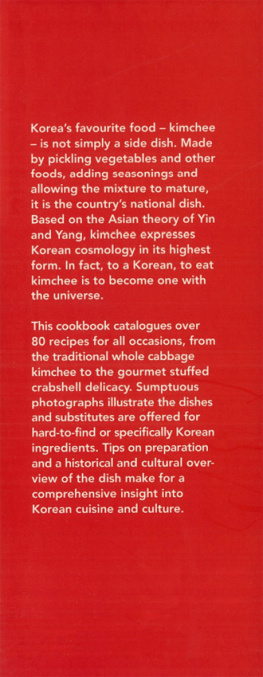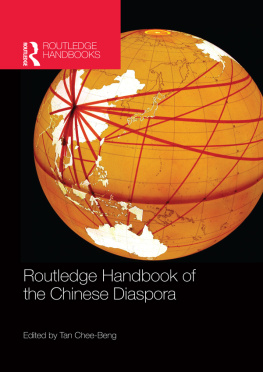
THE ORIGINS, HISTORY AND CULTURE OF KIMCHEE
From ancient times to the present day, the fiery flavors of kimchee have dominated the Korean cultural landscape. Here we trace the development of the various types of kimchee, its references in Korean literature, past and present, and place it in its historical context. Both as a symbol of Korean cosmology and as an ordinary item in every household, kimchee is a unique dish found nowhere else in the world.

This ceramic jar, from the Kaya Confederation (c. 1st century AD), measures 89 cm in height, 55 cm across the mouth, 117 cm around the neck and 227 cm around the belly. Made of baked clay, it was used to store or move foodstuffs. The big clay jars commonly unearthed at sites that date to the period of the Three Kingdoms often show signs of having been used to store kimchee.

The character for pickle - pronounced ju in Chinese and cho in Korean.
It is generally acknowledged in the West that there are four cardinal tastes: sweet sour, bitter, and salty. Koreans, however, have an additional one, which they regard above those, namely, pungency. Pungency is one of the indispensable tastes in every Korean meal, necessary for stimulating the flow of saliva and the appetite.
The unique pungency of Korean food is the fermented flavor that is found in pickles (kimchee) and basic Korean condiments such as soybean sauce, soybean paste and chili paste. This flavor is the result of a kind of 'controlled spoilage' and is a distinctive characteristic of Korean cuisine,
Preserving Food
Drying was the very first method humans used to preserve foods. Later, they discovered that foods could also be preserved by salting, and later still, by fermentation. Although it was possible to store grains and nuts for long periods without using any of these methods, foods with high moisture content such as fish, meats, and vegetables could not be kept for any reasonable length of time without some special method of preservation. With vegetables, drying was not only difficult to carry out successfully, but also caused the vegetables to lose their nutritional value and flavor. Once salt was discovered, it was found that foodstuffs stored in salt both kept well and were good to eat Salting softened fibers, making the vegetables easier to chew, and induced amino and lactic acid fermentation. The earliest salt was found in seawater, rock-salt deposits or salt flats. Later, commercial salt was used.
Since ancient times, Korean people preserved wild vegetables by pickling. They also developed and mastered the techniques of salting, brining and fermenting. Once cultivation of vegetables began and herbs and spices were introduced from abroad, these new ingredients were mixed with existing ones to create new forms of foods. Such newly introduced vegetables were adapted to the Korean land and climate, and further developed.
The development of the kinds of kimchee Koreans eat today started when vegetables were brought in from abroad; especially revolutionary was the introduction of cabbages that formed a dense head. New concoctions made use of wild vegetables to create new kinds of kimchees, such as the honhap kimchee, sokpakchi, and pyolmi kimchee. The cultivation of head cabbages also led to the development of lactic-acid fermentation. As people experienced the efficacy of using spices and fermented fish paste in addition to fish or meat as appropriate, the kinds of kimchees commonly found today gradually came into being.

Rice is always served in Korean households along with vegetable, meat or fish dishes and the ubiquitous kimchee.
Defining Kimchee
The earliest record of kimchee is in China's oldest collection of poetry, the Book of Odes, which was written nearly 3,000 years ago. The section entitled 'Xiao Ya' contains a stanza: "On the bank of the field, a cucumber has grown. If you slice it up, pickle it, and offer it to your ancestors, your progeny will live long and you'll receive the blessings of Heaven." The character for pickle (pronounced ju in Chinese and cho in Korean) means kimchee. This ju is the ancestor of kimchee.
The earliest appearance of this character in extant Korean literature occurs in Tonggugisanggukship or the History of the Koryo Dynasty, written by Yi Kyu-bo (1168-1241). Nevertheless, it would be unreasonable to assume that this is actually the oldest documented reference to kimchee in Korea. Some scholars believe the word kimchee is derived from a combination of two Chinese characters meaning 'salted vegetables.' In August 1966, at the Second International Academic Conference on Food Science and Engineering in Warsaw, Poland, it was decided that k-i-m-c-h-e-e should be the official English spelling of this Korean national dish.

A painting by an anonymous artist of the Choson Dynasty. The earliest extant record of cabbage in Korea is found in a Koryo Dynasty book entitled Hyangyakkugumbang, but references to cabbage in books on agriculture were rare until the middle of the Choson Dynasty. Before this, radish was the main vegetable. It was not common to make kimchee out of cabbage until the introduction of Brassica pekinensis from China some time after it was first cultivated in the region of Beijing in the mid 1700s.

Tonggugisanggukchip (History of the Koryo Dynasty) , written by Yi Kyu-bo of the Koryo Dynasty, is believed to contain the oldest extant written reference to kimchee in Korea. The book is open at the section entitled 'Kapoyugyong,' a poem about six vegetables grown in home gardens: cucumbers, eggplant, turnips, Welsh onions and gourds.
History
The earliest written references to kimchee date from the second half of the Koryo Dynasty (918-1392). Nevertheless, in view of the fact that such Chinese texts as the Hou Zhou Shu say that cereals, fruits, and vegetables were grown in Paekche and Silla as they were in China, and the production of alcoholic beverages was the same as in China, it seems quite likely that kimchee-like fermented vegetable dishes were already being made and eaten during Korea's Three Kingdom period (4th century-mid-7th century). This was an era when exchanges with China flourished. Methods of pickling vegetables would have been similar to those used in China, and because this period predates the cultivation of vegetables brought in from distant lands, it is probable that the vegetables used in kimchee were local wild species.
Korean food underwent great changes during the Choson Dynasty (1392-1894). Of paramount importance was the introduction of chilies at the end of the 16th century. Some scholars maintain that chilies were brought to Korea directly by Portuguese soldiers who were among the Ming reinforcements that aided Korea during the Japanese invasions. (Whether this is true or not, it is known that chili powder was not widely used in kimchee until the 18th century, nearly 200 years after chili peppers were introduced.) Korean people have always had a taste for food that is hot, both in terms of temperature and spiciness, and the strong flavors of mustard and black pepper have always been popular. When chilies became available, Koreans started to add them to kimchee, which had previously been pickled in a brine flavored with Japanese pepper or fennel. They learned that chilies helped to keep kimchee from spoiling and allowed for the use of less salt.



















